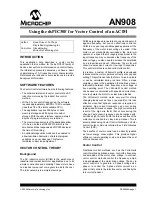
AN908
DS00908A-page 12
2004 Microchip Technology Inc.
Phase Current Feedback
The vector control application requires knowledge of
the 3-phase motor currents. This application is
designed to use the isolated hall-effect current trans-
ducers found on the dsPICDEM MC1H power module.
These transducers are active devices that provide a
200-KHz bandwidth, 0-5 volt feedback signal. The hall-
effect devices have been used in this application for
convenience and safety reasons. The signal from these
devices can be connected directly to the dsPIC A/D
converter. For your end application, you can choose to
measure currents using shunt resistors installed
in each leg of the 3-phase inverter. The shunt resistors
offer a less expensive solution for current
measurement.
Motor Wiring Configuration
Most 3-phase ACIM’s, including the Leeson motor, can
be wired for 208V or 460V operation. If you are using
the dsPICDEM MC1 system to drive your motor, you
should wire the motor for 208V operation.
The vector control application does not regulate the DC
bus voltage. However, a 208V motor will operate cor-
rectly from a 120V source with limited speed and
torque output.
Jumper Placement
All jumpers on the 3-Phase High Voltage Power Mod-
ule can be left at the default settings. If you have
removed the cover of the power module to make mod-
ifications, please refer to the power module user’s
guide for the default jumper configuration.
The following jumper configuration should be used for
the motor control development board.
• The isolated hall-effect current sensors are used
to measure the motor phase currents. Ensure LK1
and LK2 (next to the 5V regulator) are placed on
pins 1 and 2.
• Switch S2 (located next to the ICD connector)
should be set to the ‘Analog’ position when
running the demo code to connect the phase
current feedback to the dsPIC analog input pins.
(S2 should be placed in the ‘ICD’ position for
device programming).
• All other jumpers should be left in their default
placements.
External Connections
• Plug the Motor Control Development Board
directly into the 37pin connector on the Power
Module.
• Make sure a dsPIC30F6010 device is installed on
the development board
• Connect the motor leads to the output of the
Power Module in the terminals labeled R,Y,B.
Connect phase 1 to ‘R’, phase 2 to ‘Y’ and phase
3 to ‘B’.
• Connect the encoder leads to the QEI terminal
block on the MCDB. Match up the pin names
screened on the MCDB with the signal names on
the encoder. Finally connect the 9V power supply
to J2 on the MCDB.
Port Usage
Table 2 indicates how the dsPIC device ports are used
in this application. This information is provided to help
you develop your hardware definition. The I/O pins that
are required for the vector control application are
shown in bold text. The application uses other pins,
such as LCD interface lines, that are not required for
the motor control function. These I/O connections may
or may not be used in your final design.
.



























